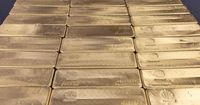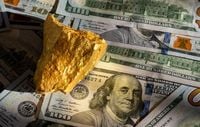In a move that sent shockwaves through international markets, the Trump administration imposed a sweeping 39% tariff on Swiss exports to the United States, targeting not only luxury watches but also gold bullion bars—two of Switzerland’s most iconic industries. The new tariffs, which took effect on August 7, 2025, have already triggered record highs in gold futures and ignited widespread concern among traders, investors, and luxury retailers both in the U.S. and abroad.
The Financial Times first reported that one-kilo and 100-ounce gold bars imported from Switzerland would be subject to the hefty trade tax, based on a ruling letter dated July 31, 2025, from the U.S. Customs and Border Protection agency. The agency clarified that these gold bars—central to Switzerland’s bullion exports—would no longer be exempt from tariffs. According to Quartz, the ruling upends long-held assumptions within the industry. Christoph Wild, president of the Swiss Association of Manufacturers and Traders of Precious Metals, explained, “The prevailing view was that precious metals remelted by Swiss refineries and exported to the U.S. could be shipped tariff-free. However, the custom code classification for different gold products is not always precise.”
Market reaction was swift and dramatic. U.S. December gold futures soared to an all-time high of $3,534.10 per ounce in early trading on August 8, before settling at $3,492.70—still up by around 1% as of 11:07 a.m. ET. The sudden spike reflects both immediate uncertainty and the anticipation of tighter supply in the world’s largest gold market. As reported by the Financial Times, gold is one of Switzerland’s largest exports to the U.S., with one-kilo bars making up the lion’s share.
But the implications reach far beyond the bullion market. The Swiss watch industry, which exported $29.5 billion worth of timepieces in 2024, is also bracing for a major hit. The United States is Switzerland’s main trade partner for watches, and the new tariff could “crush demand for new Swiss watches,” according to Yahoo Finance. Paul Altieri, CEO of Bob’s Watches, painted a stark picture: “A 39% markup could make even a stainless-steel Submariner at retail jump from $10,000 to nearly $14,000.” With such a dramatic price increase, many buyers are already flocking to the secondhand market to avoid the tariff-induced surge.
The effects are already being felt. Following a previous 10% tariff earlier in 2025, prices for luxury brands like Patek Philippe, Audemars Piguet, and Vacheron Constantin rose by 6.5% to 6.9% in the second quarter, according to Morgan Stanley and WatchCharts. The latest hike is expected to accelerate this trend. Subdial, a watch trading site, told Yahoo Finance, “If they increase prices in the US only, we may see a knock on effect in other markets. It seems more likely that brands will increase prices across all geographies (so as to maintain pricing parity, an important principle within luxury), and just accept lower margins on US stock on account of tariffs.”
Dealers and retailers are scrambling to respond. Watches of Switzerland, a major retail partner for Rolex, said in a statement, “We note the announcement of the proposed new US tariff rate on imports from Switzerland due to come into effect on 7th August and will continue to work closely with our brand partners to mitigate any potential impact.” For many, mitigation means either passing the cost to customers or absorbing some of the impact themselves—neither of which is an easy pill to swallow.
Rolex, which produces over a million luxury watches a year and recently acquired Bucherer (operator of the Tourneau chain in the U.S.), has not commented publicly. However, its certified pre-owned (CPO) watch programs may offer a lifeline, as buyers shift from new to used models to sidestep the tariff. Yet, as Bob’s Watches notes, “used prices are climbing in sympathy as demand rises.”
The rationale behind the Trump administration’s move appears multifaceted. According to analysis by the American Institute for Economic Research (AIER), the tariffs serve several possible purposes: raising revenue, targeting Switzerland’s dominance in gold refining, restricting foreign supply, and controlling domestic markets. There’s also speculation that the measure could be a precursor to a major policy shift—potentially the revaluation of U.S. gold reserves, currently booked at just $42 per ounce. By making imported gold bars prohibitively expensive, the U.S. could accumulate domestic reserves and prepare for a new monetary framework, possibly even a partial return to a gold-backed dollar.
There’s a strategic element at play as well. AIER notes, “By imposing a tariff on large gold imports, the US could limit Switzerland’s ability to sell refined gold at favorable prices, disrupting its dominance.” This could be seen as a response to ongoing trade tensions and an attempt to reduce America’s reliance on foreign gold pricing—an issue that has long been a point of contention in international finance.
Yet, history suggests that such interventions often have unintended consequences. As AIER points out, the U.S. government has a long record of manipulating gold markets, from the Roosevelt administration’s 1933-34 gold confiscation and revaluation, to Nixon’s closure of the gold window in the early 1970s. These episodes were often justified as necessary for “monetary stability,” but frequently led to market distortions and loss of confidence.
Indeed, the new tariffs may already be creating opportunities for arbitrage. If U.S. gold prices remain elevated relative to London, Zurich, or Hong Kong, traders could seek to bypass the tariffs by repackaging gold into smaller, untaxed units or using complex derivatives to exploit price differentials. Over time, such actions could undermine the very goals of the tariff, leading to increased volatility and reduced liquidity in the U.S. market.
For Swiss watchmakers and gold refiners, the stakes couldn’t be higher. The watch industry alone employs thousands of artisans and supports a vast network of corporate and retail roles. While some companies, like Rolex and Watches of Switzerland, may cushion the blow with pre-owned sales and global price adjustments, smaller brands and independent retailers face an uncertain future.
Even President Trump’s own business interests could be caught in the crossfire. Last year, he licensed his name for a range of high-end Swiss-made watches, including a $100,000 solid gold tourbillon model. The new tariffs could make such luxury items even more exclusive—and more expensive—for American buyers.
As the dust settles, one thing is clear: the 39% tariff on Swiss gold bars and watches marks a dramatic escalation in U.S. trade policy, with ripple effects that will be felt across financial markets, luxury goods, and the broader global economy. Whether this signals a temporary gambit or the start of a more fundamental shift in America’s approach to monetary policy and global trade remains to be seen. For now, both investors and consumers are left navigating a landscape where the price of gold—and time itself—just got a lot higher.






